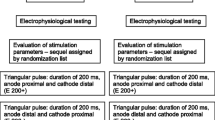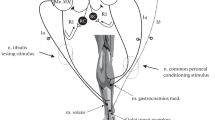Summary
The efficacy of electrical stimulation on a chronically denervated muscle depends on stimulus parameters, which have an important influence on the development of atrophy. Stimulus frequency and/or total activity are particularly responsible for the development of some histological, biochemical and contractile features. The present study in 18 rabbits deals with a recently developed electrical stimulus, which had proved effective in maintaining muscle force following denervation. This current has (1) unusual long bidirectional rectangular impulses (20 ms) and (2) a frequency of 25 Hz, which is between the frequencies of fast- and slow-firing motor units. Electrical stimulation began 28 (in one animal 53) days after total motor and sensory denervation of the right hindleg, and was continued until the end of the experiment, up to 205 days. To mimic a therapeutic regimen, which should be agreeable to patients, daily treatment times were kept to a minimum (2 × 6 min), and surface electrodes were used. Morphometric evaluation of the fast flexor digitorum sublimis muscle showed that such electrical stimulation was able to preserve fibre diameter at a level of 72–86% of the initial values for several months, while unstimulated fibres showed the usual atrophy with a decrease of diameters below 40% of normal. The stimulation induced a “hybrid” fibre type with properties of a slow muscle (rich in mitochondria in NADH-dependent tetrazolium reductase staining and electron microscopy) as well as of a fast-twitch muscle (fibre type IIb in myofibrillar ATPase stainings).
Similar content being viewed by others
References
Al-Amood WS, Finol HJ, Lewis DM (1986) Chronic stimulation modifies the isotonic shortening velocity of denervated rat slow twitch muscle. Proc R Soc Lond B 228:42–58
Amphlett G, Perry S, Syska H, Brown M, Vrbova G (1975) Cross-innervation and the regulatory protein systme of rabbit soleus muscle. Nature 257:602–604
Bajusz E (1964) “Red skeletal muscle fibers”: relative independence of neural control. Science 145:938–939
Bowden RE, Gutmann E (1944) Denervation and reinnervation of human voluntary muscle. Brain 67:273–310
Buller A, Eccles J, Eccles R (1960) Interaction between motor-neurons and muscles in respect of the characteristic speed of their responses. J Physiol (Lond) 150:417–439
Carraro U, Catani C, Belluco S, Cantini M, Marchioro L (1986) Slow-like electrostimulation switches on slow myosin in denervated fast muscle. Exp Neurol 94:537–553
Carraro U, Catani C, Saggin L, Zrunek M, Szabolcs M, Gruber H, Streinzer W, Mayr W, Thoma H (1988) Isomyosin changes after functional electrostimulation of denervated sheep muscle. Muscle Nerve 11:1016–1028
Chi MMY, Hintz CS, Henriksson J, Salmons S, Hellendahl RP, Park JL, Nemeth PM, Lowry OH (1986) Chronic stimulation of mammalian muscle: enzyme changes in individual fibers. Am J Physiol 251:333–342
DeCoster W, DeReuck J, Vander Eecken H (1985) Early changes in experimental denervated rat gastrocnemius muscle. Acta Neuropathol 67:114–120
Donselaar Y, Eerbek O, Kernell D, Verhey B (1987) Fiber size and histochemical staining characteristics in normal and chronically stimulated fast muscles of cat. J Physiol (Lond) 382:237–254
Edström L, Grimby L (1986) Effect of exercise on the motor unit. Muscle Nerve 9:104–126
Eerbek O, Kernell D, Verhey B (1984) Effects of fast and slow patterns of tonic long-term stimulation on contractile properties of fast muscle in cat. J Physiol (lond) 352:73–90
Eichhorn KF, Schubert W, David E (1984) Maintenance, training and functional use of denervated muscles. J Biomed Eng 6:205–211
Eisenberg B, Brown J, Salmons S (1984) Restoration of fast muscle characteristics following cessation of chronic stimulation. Cell Tissue Res 238:221–230
Gauthier G, Burke R, Lowey S, Hobbs A (1983) Myosin isozymes in normal and cross-reinnervated cat skeletal muscle fibers. J Cell Biol 97:756–771
Gibson JNA, Smith K, Rennie MJ (1988) Prevention of disuse muscle atrophy by means of electrical stimulation: maintenance of protein synthesis. Lancet II:767–770
Greathouse DG, Nitz AJ, Matulionis DH, Currier DP (1986) Effects of short-term electrical stimulation on the ultrastructure of rat skeletal muscles. Phys Ther 66:946–953
Gutmann E, Guttmann L (1944) The effect of galvanic exercise on denervated and reinnervated muscles in the rabbit. J Neurol Neurosurg Psychiatry 7:7–17
Gutmann E, Zelena J (1962) Morphological changes in the denervated muscle. In: Gutmann E (ed) The denervated muscle. Czechoslovak Academy of Sciences, Prague, pp 57–102
Harada Y (1983) Experimental study of denervated rat muscle. I. Histochemical and electrophysiological observations of denervated rat muscle. J Jpn Orthop Assoc 57:849–857
Harada Y (1983) Experimental study of denervated rat muscle. II. The effects of electrical stimulation on the denervated rat muscles. J Jpn Orthop Assoc 57:859–867
Hatano E, Tsuge K, Ikuta Y, Yoshioka K, Hiramatsu N (1981) Electrical stimulation on denervated skeletal muscles. In: Gorio A, Millesi H, Mingrino S (eds) Posttraumatic peripheral nerve regeneration: experimental basis and clinical implications. Raven Press, New York, pp 469–478
Hennig R, Lomo T (1985) Firing patterns of motor units in normal rats. Nature 314:164–166
Herbison GJ, Teng CS, Reyes T, Reyes O (1971) Effect of electrical stimulation on denervated muscle of rat. Arch Phys Med Rehabil 52:516–522
Hudlicka O, Tyler KR, Srihari T, Heilig A, Pette D (1982) The effect of different patterns of long-term stimulation on contractile properties and myosin light chains in rabbit fast muscles. Pflügers Arch 393:164–170
Jolesz F, Sreter FA (1981) Development, innervation and activity-pattern induced changes in skeletal muscle. Annu Rev Physiol 43:531–552
Karpati G, Engel WK (1968) Correlative histochemical study of skeletal muscle after supersegmental denervation, peripheral nerve section and skeletal fixation. NEurology 18:681–692
Kernell D, Eerbeek O, Verhey A, Donselaar Y (1987) Effects of physiological amounts of high- and low-rate chronic stimulation on fast-twitch muscle of the cat hindlimb. I. Speed- and force-related properties. J Neurophysiol 58:598–613
Kernell D, Donselaar Y, Eerbeek O (1987) Effects of physiological amounts of high- and low-rate chronic stimulation on fast-twitch muscle of the cat hindlimb. II. Endurance-related properties. J Neurophysiol 58:614–626
Lewis D, Rowlerson A, Webb S (1982) Motor units and immuno-histochemistry of cat soleus after long periods of cross-reinnervation. J Physiol (Lond) 325:403–418
Lomo T, Westgaard R, Engebretsen L (1980) Different stimulation patterns affect contractile properties of denervated rat soleus muscles. In: Pette D (ed) Plasticity of muscle. de Gruyter, Berlin, pp 297–309
Lomo T, Gundersen K, Hennig R, Westgaard R (1985) Maintenance and regulation of contractile properties by chronic stimulation of denervated muscle in the rat: role of impulse pattern. In: Eccles J, Dimitrijevic M (eds) Recent achievements in restorative neurology: upper motorneurone function and dysfunction. Karger, Basel, pp 249–262
Mokrusch T, Eichhorn KF, Sack G, Iglesias V, Klarner H, Sembach O, David E, Neundörfer B (1988) Elektrotherapie schlaffer Lähmungen — ein neuer Ansatz. Biomed Tech 33:231–235
Nemeth PM (1982) Electrical stimulation of denervated muscle prevents decreases in oxidative enzymes. Muscle Nerve 5:134–139
Niederle B, Mayr R (1978) Course of denervation atrophy in type I and type II fibres of rat extensor digitorum longus muscle. Anat Embryol 153:9–21
Nimmo MA, Snow DH (1983) Skeletal muscle fibre composition in New Zealand white rabbits, wild rabbits and wild rabbits bred in captivity: effect of heredity. Comp Biochem Physiol 74A:955–959
Nix WA (1986) Effect of electrical stimulation on denervated muscle. In: Nix WA, Vrbova G (eds) Electrical stimulation and neuromuscular disorders. Springer, Berlin Heidelberg New York, pp 115–124
Nix WA, Dahm M (1987) The effect of isometric short-term electrical stimulation on denervated muscle. Muscle Nerve 10:136–143
Peter J, Barnard R, Edgerton V, Gillespie CSK (1972) Metabolic profiles of three fiber types of skeletal muscle in guinea pigs and rabbits. Biochemistry 11:2627–2633
Pette D, Heilmann C (1977) Transformation of morphological, functional and metabolic properties of fast-twitch muscle as induced by long-term electrical stimulation. Basic Res Cardiol 72:247–253
Pette D, Tyler KR (1983) Response of succinate dehydrogenase activity in fibres of rabbit tibialis anterior msucle to chronic nerve stimulation. J Physiol (Lond) 338:1–9
Pette D, Ramirez BU, Müller W, Simon R, Exner GU, Hildebrand R (1975) Influence of intermittent long-term stimulation on contractile, histochemical and metabolic properties of fibre populations in fast and slow rabbit muscles. Pflügers Arch 361:1–7
Pette D, Müller W, Leisner E, Vrbova G (1976) Time dependent effects on contractile properties, fibre population, myosin light chains and enzymes of energy metabolism in intermittently and continuously stimulated fast twitch muscles of the rabbit. Pflügers Arch 364:103–112
Reichmann H (1985) Interspecies differences in aerobic oxidative capacities of muscle fibre populations in various mammals. Acta Histochem [Suppl] 301:53–56
Reichmann H, Nix W (1985) Changes of energy metabolism, myosin light chain composition, lactate dehydrogenase isozyme pattern and fibre type distribution of denervated fast-twitch muscle from rabbit after low frequency stimulation. Pflügers Arch 404:244–249
Reichmann H, Srihari T, Pette D (1983) Ipsi- and contralateral fibre transformation by cross-reinnervation. A principle of symmetry. Pflügers Arch 397:202–208
Romanul F, Meulen J van der (1967) Slow and fast muscles after crossinnervation. Arch Neurol 17:387–402
Rubinstein N, Mabuchi K, Pepe F, Salmons S, Gergely J, Sreter F (1978) Use of type-specific antimyosins to demonstrate the transformation of individual fibers in chronically stimulated rabbit fast muscles. J Cell Biol 79:252–261
Salmons S (1987) Biochemical and morphological evidence of increased protein and nucleic acid synthesis in chronically stimulated rabbit skeletal muscle. J Anat 152:229
Salmons S, Vrbova G (1969) The influence of activity on some contractile characteristics of mammalian fast and slow muscles. J Physiol (Lond) 201:535–549
Salmons S, Gale D, Sreter F (1978) Ultrastructural aspects of the transformation of muscle fiber type by long term stimulation changes in Z discs and mitochondria. J Anat 127:17–31
Sreter FA, Pinter K, Jolesz F, Mabuchi K (1981) Fast to slow transformation of fast muscles in response to long-term phasic stimulation. Exp Neurol 75:95–102
Stewart DM (1962) Protein composition of denervated muscle. Am J Physiol 202:281–284
Sun KS, Nobuo S, Andersen PJ (1963) Orthogonal diameters in the analysis of muscle fibre size and form. Nature 200:1221–1224
Vrbova G (1963) The effect of motoneuron activity on the speed of contraction of striated muscle. J Physiol (Lond) 169:513–526
Zrunek M, Carraro U, Catani C, Scabolcs M, Gruber H, Streinzer W, Mayr W, Thoma H (1986) Funktionelle Elektrostimulation des denervierten M. posticus im Tierversuch: Histound biochemische Ergebnisse. Laryngol Rhinol Otol (Stuttg) 65:621–627
Author information
Authors and Affiliations
Rights and permissions
About this article
Cite this article
Mokrusch, T., Engelhardt, A., Eichhorn, KF. et al. Effects of long-impulse electrical stimulation on atrophy and fibre type composition of chronically denervated fast rabbit muscle. J Neurol 237, 29–34 (1990). https://doi.org/10.1007/BF00319664
Received:
Revised:
Accepted:
Issue Date:
DOI: https://doi.org/10.1007/BF00319664




